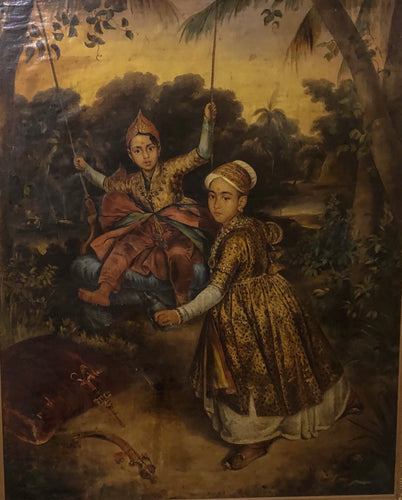
The Royal Story of a Lullaby ‘Omana Thinkal Kidavo’!
Share
One fine morning, when I was at my parents’ place for Christmas, during a casual conversation in the kitchen, I thought of surprising my dad (Achachan) with a piece of historical fact that I had discovered very recently about the popular lullaby ‘Omana Thingal Kidavo’!
I knew that this song is quite familiar to all Malayalees, as well as some non-Malayalees across the country, especially in the South. But my question to my dad was to guess the age of this song! 😉
So, let me ask you the same question. Can you guess the age of this song? Meanwhile, let me give you a small piece of history about who wrote the song, for whom, why, and when.
A Kingdom in Crisis
Around 1798, when Avittom Thirunal Balarama Varma took over the throne after the death of King Dharma Raja, the Kingdom fell into a chaotic state during hhis reign and after his death in 1810. Adding to this turmoil there was also a threat to the throne as a new policy was established by the East India company which the company forcefully applied on the allied princely states.

According to this policy, if a ruler of a princely state died without a biological male heir, the British East India Company would annex the kingdom. A well-known victim of this policy was Rani Lakshmibai of Jhansi, who joined the 1857 revolt after the British refused to recognize her adopted son as her heir. States like Satara, Jhansi, and Nagpur were the victim states annexed by the British under this policy.
This policy was informally introduced during the time of two early Governors-General of India Warren Hastings (1773–1785) and Lord Cornwallis(1786–1793). This policy didn’t allow the kingdom to pass to an adopted heir or other relatives. It was cleverly used as an excuse to expand British East India Company territories.
Later in the future, this policy was made official and called ‘Doctrine of Lapse’ by James Broun-Ramsay, 1st Marquess of Dalhousie when he became the Governor General of India between the year 1848 and 1856. Dalhousie simply codified what was already a widely used tactic in early 1800s.

The Travancore Kingdom, however, followed the ‘Marumakkathayam’ system, where succession to the throne was determined through the King’s sister’s son, not the King’s own son. Travancore Kingdom faced a succession crisis after the death of King Avittom Thirunal Balarama Varma in 1810. With no male heir to the throne, the King’s adopted sister, Gowri Lakshmi Bayi, became the Queen at the age of 20. She was the only Queen of Travancore to rule in her own right, which she did until she became pregnant and later naturally became the regent Queen.

A Kingdom’s Hope
The news of the Queen’s pregnancy spread like wildfire across the kingdom. The unborn baby, believed to be the kingdom’s savior, was proclaimed the King and referred to as “Garbha Sreeman”.

In 1813, the Queen gave birth to a son on the Swathi Nakshatra day. Swathi is one of the 27 Nakshatras (constellations) in Vedic astrology, and the Kings and Queens of Travancore were traditionally named after their stars.
The whole kingdom celebrated the birth of the crowned prince, who was named Sri Swathi Thirunal Rama Varma III. He would later become a renowned musician and composer, credited with over 400 classical compositions in both Carnatic and Hindustani styles.
Who Composed Omana Thingal Kidavo?
Iranyimman Thampi, also known as Iravi Varman Thampi, was a musician and composer in the royal court of Travancore. Born into the royal family, he had a deep love for music and poetry. Despite having no formal guru, he cultivated his musical talents on his own, making him a truly self-made personality.

In the 1790s, at the age of 14, Thampi gained his first recognition in the palace by dedicating a poem to his uncle, Karthika Thirunal Dharmaraja, the then King of Travancore and successor of King Marthanda Varma, the founder of the Travancore Kingdom.

For Whom, Why, and When Was This Lullaby Composed?
When baby Swathi Thirunal was born, Queen Gowri Lakshmi Bayi requested Irayimman Thampi to compose a song to put the precious baby prince to sleep. This was no ordinary prince, he was the long-awaited heir who had saved the Travancore Kingdom from falling into British hands due to the ‘Doctrine of Lapse’.
Thus, in 1813, the famous Malayalam lullaby Omana Thingal Kidavo was composed for baby Swathi Thirunal.



A Family Surprise
And that’s the short history I told my dad about the most famous, 211 years old Malayalam lullaby ‘Omana Thingal Kidavo’, composed for Swathi Thirunal.
To my surprise, my dad sang a small raga of a Carnatic composition by Swathi Thirunal. He explained that his father, a Carnatic singer and vidwan, used to teach his students songs composed by Swathi Thirunal. My dad thought he had forgotten these songs due to a lack of practice, but to his and my surprise, he sang it beautifully.
This blog is dedicated to my father, who surprised me with his rendition of a ragam composed by the great musician and King Swathi Thirunal from the early 1800s. click here to see how he surprised me;


1 comment
Very interesting information. Thanks for sharing Priya.